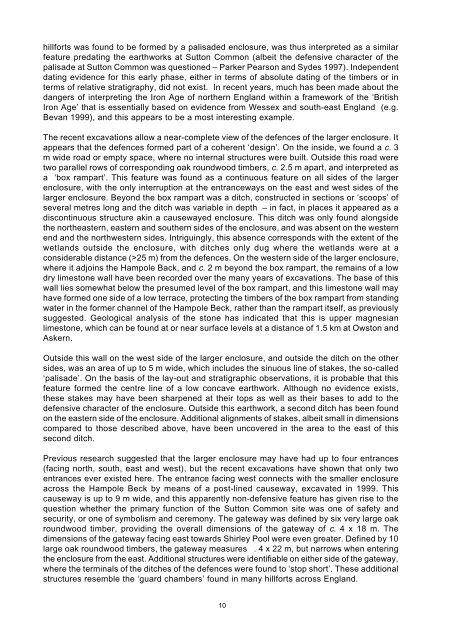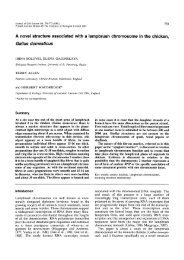Sutton Common Updated project design - University of Exeter
Sutton Common Updated project design - University of Exeter
Sutton Common Updated project design - University of Exeter
Create successful ePaper yourself
Turn your PDF publications into a flip-book with our unique Google optimized e-Paper software.
hillforts was found to be formed by a palisaded enclosure, was thus interpreted as a similar<br />
feature predating the earthworks at <strong>Sutton</strong> <strong>Common</strong> (albeit the defensive character <strong>of</strong> the<br />
palisade at <strong>Sutton</strong> <strong>Common</strong> was questioned – Parker Pearson and Sydes 1997). Independent<br />
dating evidence for this early phase, either in terms <strong>of</strong> absolute dating <strong>of</strong> the timbers or in<br />
terms <strong>of</strong> relative stratigraphy, did not exist. In recent years, much has been made about the<br />
dangers <strong>of</strong> interpreting the Iron Age <strong>of</strong> northern England within a framework <strong>of</strong> the ‘British<br />
Iron Age’ that is essentially based on evidence from Wessex and south-east England (e.g.<br />
Bevan 1999), and this appears to be a most interesting example.<br />
The recent excavations allow a near-complete view <strong>of</strong> the defences <strong>of</strong> the larger enclosure. It<br />
appears that the defences formed part <strong>of</strong> a coherent ‘<strong>design</strong>’. On the inside, we found a c. 3<br />
m wide road or empty space, where no internal structures were built. Outside this road were<br />
two parallel rows <strong>of</strong> corresponding oak roundwood timbers, c. 2.5 m apart, and interpreted as<br />
a ‘box rampart’. This feature was found as a continuous feature on all sides <strong>of</strong> the larger<br />
enclosure, with the only interruption at the entranceways on the east and west sides <strong>of</strong> the<br />
larger enclosure. Beyond the box rampart was a ditch, constructed in sections or ‘scoops’ <strong>of</strong><br />
several metres long and the ditch was variable in depth – in fact, in places it appeared as a<br />
discontinuous structure akin a causewayed enclosure. This ditch was only found alongside<br />
the northeastern, eastern and southern sides <strong>of</strong> the enclosure, and was absent on the western<br />
end and the northwestern sides. Intriguingly, this absence corresponds with the extent <strong>of</strong> the<br />
wetlands outside the enclosure, with ditches only dug where the wetlands were at a<br />
considerable distance (>25 m) from the defences. On the western side <strong>of</strong> the larger enclosure,<br />
where it adjoins the Hampole Back, and c. 2 m beyond the box rampart, the remains <strong>of</strong> a low<br />
dry limestone wall have been recorded over the many years <strong>of</strong> excavations. The base <strong>of</strong> this<br />
wall lies somewhat below the presumed level <strong>of</strong> the box rampart, and this limestone wall may<br />
have formed one side <strong>of</strong> a low terrace, protecting the timbers <strong>of</strong> the box rampart from standing<br />
water in the former channel <strong>of</strong> the Hampole Beck, rather than the rampart itself, as previously<br />
suggested. Geological analysis <strong>of</strong> the stone has indicated that this is upper magnesian<br />
limestone, which can be found at or near surface levels at a distance <strong>of</strong> 1.5 km at Owston and<br />
Askern.<br />
Outside this wall on the west side <strong>of</strong> the larger enclosure, and outside the ditch on the other<br />
sides, was an area <strong>of</strong> up to 5 m wide, which includes the sinuous line <strong>of</strong> stakes, the so-called<br />
‘palisade’. On the basis <strong>of</strong> the lay-out and stratigraphic observations, it is probable that this<br />
feature formed the centre line <strong>of</strong> a low concave earthwork. Although no evidence exists,<br />
these stakes may have been sharpened at their tops as well as their bases to add to the<br />
defensive character <strong>of</strong> the enclosure. Outside this earthwork, a second ditch has been found<br />
on the eastern side <strong>of</strong> the enclosure. Additional alignments <strong>of</strong> stakes, albeit small in dimensions<br />
compared to those described above, have been uncovered in the area to the east <strong>of</strong> this<br />
second ditch.<br />
Previous research suggested that the larger enclosure may have had up to four entrances<br />
(facing north, south, east and west), but the recent excavations have shown that only two<br />
entrances ever existed here. The entrance facing west connects with the smaller enclosure<br />
across the Hampole Beck by means <strong>of</strong> a post-lined causeway, excavated in 1999. This<br />
causeway is up to 9 m wide, and this apparently non-defensive feature has given rise to the<br />
question whether the primary function <strong>of</strong> the <strong>Sutton</strong> <strong>Common</strong> site was one <strong>of</strong> safety and<br />
security, or one <strong>of</strong> symbolism and ceremony. The gateway was defined by six very large oak<br />
roundwood timber, providing the overall dimensions <strong>of</strong> the gateway <strong>of</strong> c. 4 x 18 m. The<br />
dimensions <strong>of</strong> the gateway facing east towards Shirley Pool were even greater. Defined by 10<br />
large oak roundwood timbers, the gateway measures c. 4 x 22 m, but narrows when entering<br />
the enclosure from the east. Additional structures were identifiable on either side <strong>of</strong> the gateway,<br />
where the terminals <strong>of</strong> the ditches <strong>of</strong> the defences were found to ‘stop short’. These additional<br />
structures resemble the ‘guard chambers’ found in many hillforts across England.<br />
10
















